



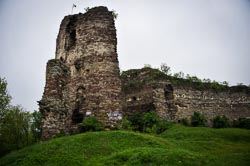
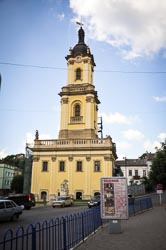
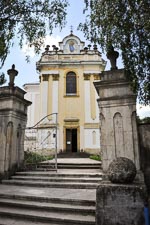
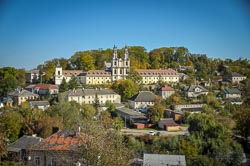

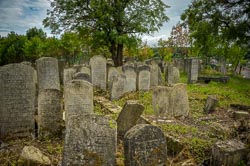

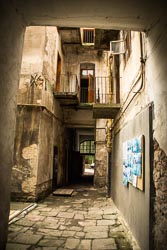
My custom tours are minimum one day long and will be customized exclusively for you. You will visit only the places you want to see and do only the things you want to do, always at your own pace. You can combine the places, finish and start your tour wherever you want.
A few places even in different towns can be included in one day program One day tour can last up to 12 hours.
You can send me a custom tour enquiry to tell me your travel plans so that I can assist you.
ukraineguideviktor@gmail.com
The earliest recorded mention of Buchach is in 1260 by Bartosz Paprocki in his book "Gniazdo Cnoty, zkąd herby Rycerstwa Polskiego swój początek mają", Kraków, 1578. In 1349, the region of Galicia became part of the Kingdom of Poland. As a part of Ruthenian Voivodeship remained in Poland from 1434 until 1772 .
It was during this time that the area experienced a large influx of Polish, Jewish and Armenian settlers. In the late 14th century, Polish nobleman Michał Awdaniec, became the owner of the town .
On July 28, 1379 M. Awdaniec founded here a Roman Catholic parish church, and built a castle.
In 1393, King Władysław II Jagiełło agreed to grant Magdeburg rights to Buchach . it was first Magdeburg-style town, located in the Galich Land. In the early 15th century, the Awdaniec family of Buchach changed its last name into Buczacki, after his main residence. Frequent invasions of the Crimean Tatars brought destruction to the town, and in 1515, it once again received the Magdeburg rights. In 1580, local castle was rebuilt: the castle was twice besieged by the Tatars (1665, 1667), who finally captured it in 1672, during the Polish–Ottoman War (1672–76). Buchach was a temporary residence of Mehmed IV.
Here in Buchach near Golden Linden on October 18, 1672, the Treaty of Buchach was signed between Polish–Lithuanian Commonwealth and the Ottoman Empire. According to this treaty, Poland handed the provinces of Ukraine and Podolia to Turkey. As a result, until 1683 Buchach was divided into two parts Polish and Ottoman.
In the 17th and 18th centuries, Buchach belonged to the Potocki family. Mikołaj Bazyli Potocki, the Starosta of Kaniv, Bohuslav, the son of Stefan Aleksander Potocki, Voivode of Belz, who became a Greek-Catholic about 1758, built here Buchach townhall with a 35-meter tower in about 1751, a late Baroque Roman Catholic Church (1761–1763), and rebuilt the castle, destroyed by the Turks. With the unification of Poland and Lithuania in 1569, the newly united kingdom extended from the Baltic to the Black Sea. Owing to its importance as a market town, Buchach had become a prominent trading centre linking Poland and the Ottoman Empire.
In 1772, Red Ruthenia, together with other areas of southwestern Poland, became a part of Kingdom of Galicia and Lodomeria — a crownland of the Habsburg Monarchy as part of the First Partition of Poland. Industry came to Buchach around the end of the 19th century. Among the small-scale industries there included a brickworks, and candle and soap factory, flour mills, a textile plant, and a necktie factory. The town also boasted a brewery and a winery. The largest factory was established early in the 1900s, when the Hilfesverein concern of Vienna set up a plant for the manufacture of wooden toys in Buchach employing some 200 workers, mainly young girls. In 1912 the Stanislaviv-based Savings and Credit Union opened a branch in Buchach, and this served as a bank for local industrialists and business.
Buchach remained a part of Austria and its successor states until the end of the First World War in 1918. The town was briefly a part of the independent West Ukrainian People's Republic before it was captured by the Republic of Poland in July 1919 after Ukrainian-Polish War. Also, between August 10 and September 15, 1920, it was occupied by the Red Army . In the Second Polish Republic, Buchach was the seat of a county in Tarnopol Voivodeship. In the 1920s, Buchach was inhabited by Jews, around 60%, Poles around 25%, and Ukrainians around 15%. On September 18, 1939 during the Soviet Invasion of Poland, Buchach was occupied by the Red Army, and incorporated into the Ukrainian SSR . In 1941, it was invaded by Nazi Germany. Before World War II, approximately 10,000 Jews lived in Buchach. According to the Soviet Extraordinary Commission, approximately 7,000 Jews were killed in Buchach during the Nazi occupation. Some were sent to Belzec, others murdered in the streets or in killing places in the forests. A few escaped to the Soviet Union or lived in the forests and fields. In May, 1943, Buchach was proclaimed Judenfrei town. When Soviets retook the town on July 21, 1944, only about 100 Jewish survivors remained. In 1945, its Polish residents were resettled into the lands of western Poland that had previously been German, and Communist authorities closed the parish church, turning it into a storage facility. Bones of the members of the Potocki family, kept in the church cellar, were thrown out, and later buried at the local cemetery.
In 1965, the neighboring village of Nahirianka was annexed to Buchach. After the fall of the Soviet Union in 1991, Buchach became a part of independent Ukraine, and new, Ukrainian government returned the church to its rightful owners.



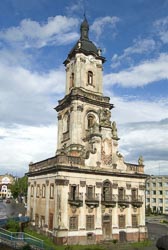
Buchach City Hall, is a unique architectural monument of the mid-18th century
The Town Hall was first constructed in 1751, a monument to the power of noble patronage. Bernard Meretyn produced for the Potocki family a structure that continues to speak across the ages of aristocratic virtue, the flow of European civilization to the most far flung locales and a reverence for civic order. Pinsel added the sculptural elements, tasteful touches both exotic and elegant. It is a shame that Meretyn’s architectural ensemble at Buchach is not better known.
A fire in 1811 burned down a wooden spire of Buchach Town Hall, the height of the building fell by at least fifteen meters, and the appearance - lost its completeness, although it did not diminish the magnificent baroque decoration. Even the mechanical clock on top of the tower retained its ability to work, continuing for more than thirty-five years to measure the time of Buchach until dismantling due to a malfunction in 1847.
But half a century later, in the heat of the second great outbreak on July 29, 1865, a part of the unique sculptural ornaments of the exterior facades was burnt down forever.
In the 19th century on the first floor of the Town Hall there was a council, after 1920 the building was given to housing and stores. And already in 1982-1992 there was an historic local lore museum and a children's art school.
The Town Hall at Buchach is a representative example of an age when noblesse oblige and artistic refinement were intertwined. Even during the dying days of the Polish-Lithuanian Commonwealth the Potocki’s were able to utilize Meretyn’s talents to build a monument to their wealth and power. At the same time, both the patron and the artist bequeathed to both present and future generations a vision of civic grandeur. Buchach’s Ratusha has managed to survive the region’s tumultuous history. The level of its artistic achievement can be ascertained from the fact that still today – even in a less than perfect state – the Ratusha manages to communicate some of its greatness to the viewer. This is a building that represents ideals of beauty, virtue, truth and justice. These timeless values are represented in a timeless piece of architecture.

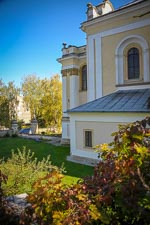
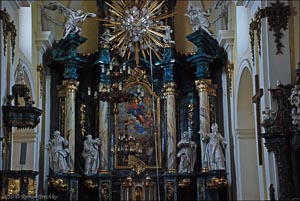
The first Rome Catholic church in Buchach appeared with the foundation of the parish in 1397. The building of the first Roman Catholic church was wooden. Soon, this church replaced the masonry shrine that was built in the Gothic style. In the middle of the eighteenth century, the church was in a very bad condition, so there was a need to build a new sanctuary.
The founder of the new temple was the owner of Buchach, Mykola Pototsky, as evidenced by the inscription above the main entrance to the church. The construction of the temple lasted for 1761-1763. The architect was originally a prominent master Bernard Mertin, and then Martin Urbanik. The sculptor Johan George Pinzel and his students worked on the interior decoration.
In Soviet times, the church was closed, and a warehouse was located in the building. The remains of Pototsky family were taken from the family vaults located in the dungeons of the church and later they set up a boiler house in the basement. Altars were also destroyed, part of the sculptures disappeared - some of them can now be seen in the Olesky castle. In 1991, the church was returned to the Roman Catholics who restored the temple.




Polish researcher Stanislav Nitsey claims that the first wooden castle in Buchach was erected in the 12th century. Researchers Anna Silvia Chizh and Bartlemy Gutovsky argued that the nobleman, Michal Abdank, built the castle.
One of the written references to the castle in Buchach is 1373, when Buchach belonged to the feudal lords Buchatsky, who were representatives of the generations of the Avdanets or Abdank arms. It is known that this outpost was built on the site of the destroyed castle of the earlier period. Modern ruins are the remnants built in the middle of the 16th century.
At the beginning of the 17th century, Buchach was one of the most important castles in Podillia. in 1620, after Buchach became the property of Stefan and Maria Potocki, the castle was expanded.
In 1648, the castle was unable to take even cossacks of Bogdan Khmelnytsky, and in 1665 and 1667 it was stormed by Tatars, and their attacks were unsuccessfully. But already in 1672, when the Turks took control of Podillya. They also stormed the Buchach castle. Sultan Mohammed IV led the storming of the Buchach castle, and Ukrainian cossacks, under the leadership of Hetman Petro Doroshenko, took an active part in the fighting on the side of the Turks. The owner of the castle Jan Potocki was not present at that time, so the defense of the castle had to be taken by his wife Theresa Potocki. Sultan's proposal to surrender was rejected. Instead, she sent him a note stating that victory over a woman would not bring him great fame. Warriors received an order to remove the siege, and the Sultan himself received gifts.
On October 18 at the same year, under the old linden, which is still preserved near the castle, the infamous "Buchachsky peace", a shameful treaty for Poland was signed, which split the city Buchach in two parts: the western part remained for Poland, the eastern part went to Turkey.
For as long as 11 years, the Strip River has become a border between East and West. In addition, according to the Treaty, the Polish–Lithuanian Commonwealth was obliged to pay tribute to the Turks each year in the amount of 22 thousand gold. The Polish Sejm did not ratify this agreement, and the war continued. In 1676, the castle again destroyed the Turkish troops under the leadership of Ibrahim Shishman.
And only in 1683 the city returned to the Polish–Lithuanian Commonwealth . In the same year, King Jan III Sobieski visited Buchach. After the victory over the Turks, returning home he drank water from a source near the castle. The source still exists now. In memory of this event, it is called "the source of Sobieski."
By order of the Polish king in 1687, the owners of Buchach Jan and Nikolai Potocki quickly rebuilt the castle, and until the middle of the XVIII century it remained capable of fighting. Subsequently, the military threat from the side of the Turks and Tatars has disappeared, and the castle begins to decay. In the early nineteenth century, Paul and Categan Potocki allowed to disassemble the defensive walls, in which the locals succeeded.




Shmuel Yosef Agnon (Hebrew: שמואל יוסף עגנון) was a Nobel Prize laureate writer and was one of the central figures of modern Hebrew fiction. In Hebrew, he is known by the acronym Shai Agnon (ש"י עגנון). In English, his works are published under the name S. Y. Agnon.
Agnon was born in Galicia, Austro-Hungarian Empire (today Ukraine). He later immigrated to the British Mandate of Palestine, and died in Jerusalem, Israel.
His works deal with the conflict between the traditional Jewish life and language and the modern world. They also attempt to recapture the fading traditions of the European shtetl (village). In a wider context, he also contributed to broadening the characteristic conception of the narrator's role in literature. Agnon shared the Nobel Prize with the poet Nelly Sachs in 1966.
Shmuel Josef Agnon (Czaczkes; 1888–1970) was born in a Hasidic family of a rabbi and expert in religious literature from Chortkiv. He received traditional Jewish education. He spent his childhood in a multicultural environment and mastered languages: Polish, Ukrainian and German. He began writing as an 8-year-old boy; in Buchach, he wrote 70 songs. He was under the influence of the German Neo-romanticism. At the beginning of the 20th century, he worked in a newspaper in Lviv.
Already in 1907, he immigrated to Palestine, where he published his first novel Agunot (Heb. Forsaken Wives) under the pen name Agnon, i. e. “The Forsaken”. This pen name later became his assumed name. Agnon wrote his first works in Yiddish and later began writing in Hebrew. In 1913, Agnon went to Germany, where he lived for over 10 years. He studied European literature and religion, Jewish history and culture, and collected old Jewish books. During this period, he published three collections of short stories about the Jews of the Eastern Europe, in the style of religious literature. In 1924, he returned to Palestine, where he continued his literary activity. In 1931, he published his novel The Bridal Canopy depicting the adventures of a poor Hasid in Galicia. For this book, he received the Nobel Prize in literature in 1966.
After a visit to Buchach in 1930, his works included Ukrainian topics: in the works Sippur pashut (Heb. A Simple Story, 1935) and Oreach nata laluna (Heb. A Guest For the Night, 1939), Agnon described his impressions from visiting his hometown. He also described the Jewish folklore, legends and fairy tales. The last novel published during the writer's life, Temol shilshom (Heb. Only Yesterday), depicting life in Palestine during the Holocaust, came out in 1945.
After the author's death, a number of his works were published posthumously. Agnon's unique literary style combines almost all forms of a centuries-old tradition of Jewish literature written in Hebrew.
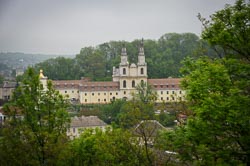

On the hillside of the Fyodor are monasteries and the church of the Fathers of Basilian. This place was once the church of St. The cross
The monastery of the Basilian Fathers on Mount Fedir was founded on Dec. 7, 1712, on the basis of the foundational letter of the Polish magnate Stefan Potocki. Pototsky, wishing to have an educated Greek Catholic Ukrainian clergy in their possessions, with the permission of the supreme secular and spiritual authorities, invited Basilian fathers to Buchach from Lithuania. The founder of the monastery was Nikolai Pototsky.
In 1714 the Lviv Catholic Archeparchy transferred the church of St. The cross for spiritual gifts to the Buchach Basilians is temporarily owned, and from 1747 - on a permanent basis. The Church of the Exaltation of the Cross was built in the 1750s and 1770s by the architect Gottfried Hoffman.
On July 29, 1865, large fires began in the Jewish residence near the church of St. Pokrovy. The day was quiet, but a strong wind blew towards the monastery and the fire roll to the monastery, the monastery burned in one hour. The bells melted, the library and school supplies burned down. The monastery turned into a ashes.
The monastery becomes the center of educational activity in Buchach. Initially, there was a boarding school for children from poor families, then - a seminary, later reorganized into a gymnasium. In 1911, the gymnasium at the monastery was reorganized into a missionary institution named after St. Josaphat, which operated intermittently until 1944. Activities of the Buchach monastery were banned by the Soviet authorities in mid-1946.
In March 1991, after the 45-year forced break in the Buchach monastery of the Exaltation of the Holy Cross, the fathers of Basilians returned. Restoration and construction works were started in 1992 and continue until today. In 1995, the Ministry of Education of Ukraine registered a historical and philosophical lyceum named after St. Josaphat Buchatsky.
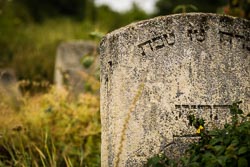
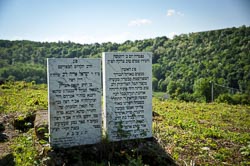

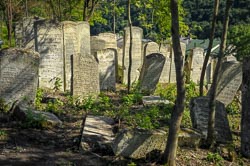
The Jewish cemetery in Buchach was founded in the 16th century.
Іt was located on the outskirts of the town, near the Strypa River. The last known burial at the cemetery took place before 1940. To this day, you can find approximately 500 matzevahs.
Many matzevahs, recovered from under roads and buildings in the city, have been transported back to the cemetery. The oldest preserved matzevah dates back to 1587.
Relatives of the writer Shmuel Yosef Agnon and of the psychiatrist Sigmund Freud, whose parents came from Buchach, are buried here.